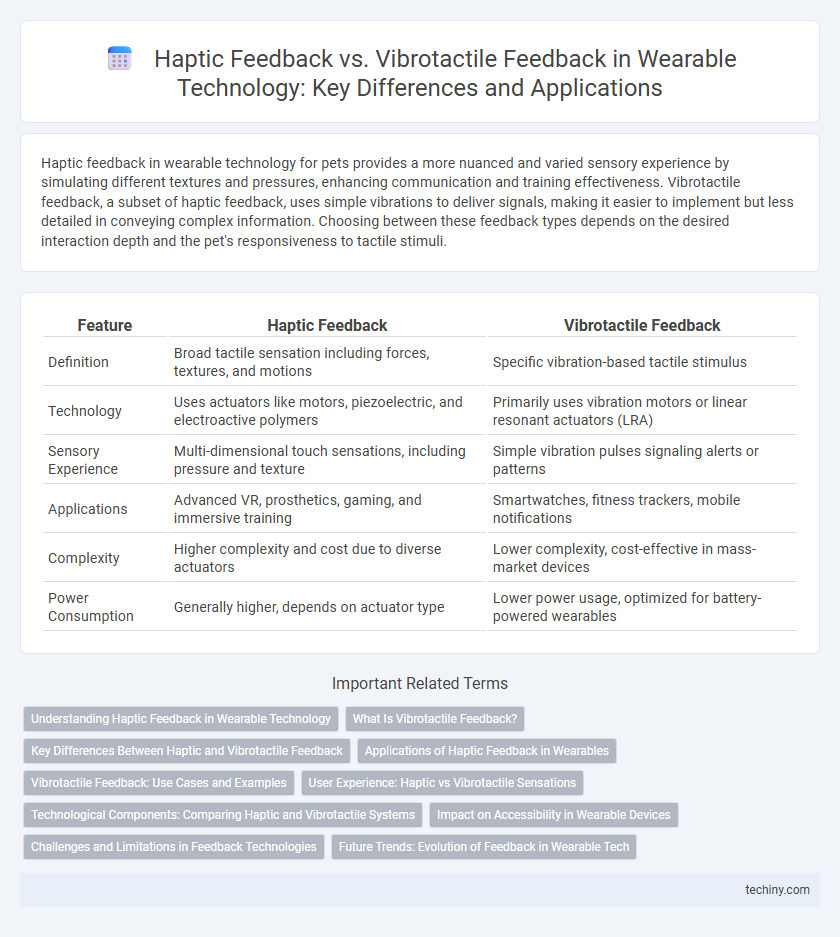Haptic feedback in wearable technology for pets provides a more nuanced and varied sensory experience by simulating different textures and pressures, enhancing communication and training effectiveness. Vibrotactile feedback, a subset of haptic feedback, uses simple vibrations to deliver signals, making it easier to implement but less detailed in conveying complex information. Choosing between these feedback types depends on the desired interaction depth and the pet's responsiveness to tactile stimuli.
Table of Comparison
| Feature | Haptic Feedback | Vibrotactile Feedback |
|---|---|---|
| Definition | Broad tactile sensation including forces, textures, and motions | Specific vibration-based tactile stimulus |
| Technology | Uses actuators like motors, piezoelectric, and electroactive polymers | Primarily uses vibration motors or linear resonant actuators (LRA) |
| Sensory Experience | Multi-dimensional touch sensations, including pressure and texture | Simple vibration pulses signaling alerts or patterns |
| Applications | Advanced VR, prosthetics, gaming, and immersive training | Smartwatches, fitness trackers, mobile notifications |
| Complexity | Higher complexity and cost due to diverse actuators | Lower complexity, cost-effective in mass-market devices |
| Power Consumption | Generally higher, depends on actuator type | Lower power usage, optimized for battery-powered wearables |
Understanding Haptic Feedback in Wearable Technology
Haptic feedback in wearable technology involves the use of tactile sensations to simulate touch, enabling users to interact with devices through pressure, texture, and motion cues. Unlike vibrotactile feedback, which primarily relies on vibrations to notify users, haptic feedback encompasses a broader range of physical stimuli, enhancing the realism and immersion of virtual experiences. Implementing advanced haptic feedback systems in wearables improves user engagement, accessibility, and interaction accuracy in applications such as virtual reality, health monitoring, and gaming.
What Is Vibrotactile Feedback?
Vibrotactile feedback is a type of haptic technology that uses vibrations to communicate information through the sense of touch, primarily deployed in wearable devices like smartwatches and fitness trackers. These vibrations provide users with intuitive alerts and notifications without relying on visual or auditory cues, enhancing user experience and interaction efficiency. Unlike broader haptic feedback, vibrotactile specifically involves oscillatory motion patterns to simulate sensations such as tapping, buzzing, or pulsing.
Key Differences Between Haptic and Vibrotactile Feedback
Haptic feedback provides a broad range of tactile sensations by simulating textures, forces, and motions through actuators like motors and pneumatics, enabling immersive interaction in wearable technology. Vibrotactile feedback specifically involves rapid vibrations targeting the skin's mechanoreceptors, primarily conveying simple alerts or notifications. The key differences lie in complexity and application scope, with haptic feedback delivering richer, multi-dimensional touch experiences and vibrotactile feedback offering more basic, vibration-based signals.
Applications of Haptic Feedback in Wearables
Haptic feedback in wearable technology enhances user experience by providing tactile sensations that simulate real-world touch, crucial for virtual reality, medical training, and gaming applications. Compared to vibrotactile feedback, which primarily uses vibrations to signal alerts or notifications, advanced haptic systems deliver nuanced textures and force feedback to improve precision and immersion. These capabilities enable wearables to support physical therapy, remote robotic control, and immersive entertainment by offering more realistic and context-aware interactions.
Vibrotactile Feedback: Use Cases and Examples
Vibrotactile feedback, a key component in wearable technology, utilizes vibrations to convey information or simulate physical sensations, enhancing user interaction and immersion. Prominent use cases include fitness trackers that provide discrete alerts for heart rate zones, smartwatches signaling incoming notifications without audible sounds, and virtual reality gloves delivering realistic touch sensations to improve gaming and training experiences. Examples like the Apple Watch's haptic alerts and Fitbit's vibration reminders demonstrate vibrotactile feedback's effectiveness in promoting seamless, non-intrusive communication in everyday wearable devices.
User Experience: Haptic vs Vibrotactile Sensations
Haptic feedback provides a rich, multi-dimensional sensory experience by simulating textures, shapes, and force, enhancing immersion in wearable technology applications. Vibrotactile feedback, relying on simple vibrations, offers basic alerts and notifications but lacks nuanced sensory detail. Users typically find haptic feedback more engaging and intuitive, improving interaction precision and overall satisfaction compared to the limited scope of vibrotactile sensations.
Technological Components: Comparing Haptic and Vibrotactile Systems
Haptic feedback systems use a combination of actuators such as piezoelectric motors, force feedback mechanisms, and ultrasonic waves to simulate realistic touch sensations, offering a multidimensional sensory experience. Vibrotactile feedback relies primarily on eccentric rotating mass (ERM) motors or linear resonant actuators (LRA) to create vibrations, providing simpler, localized tactile cues. The technological components in haptic feedback enable complex force and texture replication, whereas vibrotactile systems focus on vibration intensity and frequency for user notifications.
Impact on Accessibility in Wearable Devices
Haptic feedback in wearable technology provides nuanced, pressure-based sensations that enhance accessibility for users with sensory impairments by delivering more intuitive and distinct signals. Vibrotactile feedback, while simpler and more commonly implemented through vibrations, offers effective alerts but may lack the precision needed for complex communication. The integration of advanced haptic feedback improves user interaction and accessibility by enabling customizable, multisensory experiences tailored to individual needs.
Challenges and Limitations in Feedback Technologies
Haptic feedback faces challenges in delivering precise, localized sensations due to limitations in actuator miniaturization and power consumption, impacting user comfort and device wearability. Vibrotactile feedback, while more energy-efficient and simpler to implement, struggles with providing varied texture and force sensations, often resulting in less immersive experiences. Both technologies encounter issues with latency and consistency, hindering seamless real-time interaction in wearable applications.
Future Trends: Evolution of Feedback in Wearable Tech
Haptic feedback and vibrotactile feedback are evolving rapidly to enhance user interaction in wearable technology, with innovations focusing on multi-dimensional sensory experiences and precise stimulus patterns. Future trends indicate the integration of electrostatic and ultrasonic feedback mechanisms alongside traditional vibration motors, enabling more realistic and localized sensations. Advances in AI-driven customization and energy-efficient designs will drive the widespread adoption of sophisticated feedback systems in health monitoring, virtual reality, and immersive communications.
Haptic Feedback vs Vibrotactile Feedback Infographic

 techiny.com
techiny.com